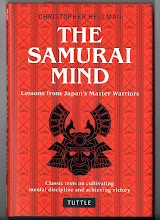 |
| From a scroll of the Sekiguchi Shinshin ryu (1810), showing iaijutsu practiced on a very interesting looking striking dummy. (From this website.) |
The art of iai seems to be one of the most
understood of the Japanese martial arts. It dates from at least the 16th
century, and probably before that, and yet it falls into that uncomfortable
ground of not being quite one thing or another. Is it for use in combat, or is
it primarily a tool for self-discipline?
Of course, the comparatively modern
discipline of iaido has as one of its
stated aims the refinement of the character of the practitioner, but there is
some contention about the whole discipline, based largely on the fact that the
principle form of practice involves starting in a kneeling position known as
seiza. Given the importance of this position in most forms of iai, it has
always been something of a mystery as to how it developed.
There have been all kinds of explanations,
some of them quite dubious, as to the origins of iai. For example, it has been
explained as a battlefield art. It has also been claimed that there was no time
that samurai would have the opportunity to draw their long swords from the
waist when seated on tatami, it is essentially of no practical use.
 |
| When we think of samurai not wearing longswords indoors, this is the kind of situation (from Kawagoe City Museum) that comes to mind. However, this was not always the case (see pictures below). |
Although iaido (and some more traditional
styles as well) are quite far removed from their ostensible purpose, i.e.
drawing the sword, cutting down an opponent and returning the sword to its
sheath, the direction in which it has developed – as a tool for polishing the
self – does, in fact, owe something to elements that were an important part of
the practice from the start.
Along with the physical practice of
wielding the sword, it has a mental component that is vital – one might even
say it is the basis of iai.
The ability to influence the opponent, to
control him, before coming to blows, is at its heart, as earlier practitioners
were keen to point out:
The founder of the Suio ryu, Mima Yoichizaemon Kagenobu wrote in the early 1600s:
The
essence of our tradition, and the attainment of an unassailable position, comes
from cutting down our opponents while the sword is still in the scabbard,
stifling our opponent’s actions and achieving victory through not drawing the
sword.
Similarly, Matsura Seizan, master of the
Shingyoto ryu echoed these ideas some 200 years later:
(Iai)
is not drawing the sword. When you match i (being or presence) with an opponent
(ai comes from the word au, which means the spirit of opposition)… it is called
projecting the spirit to give victory… the potential of drawing the sword and
cutting down the opponent is present while the sword is still sheathed.
This aspect does exist in all bugei, but iai
offers a particularly concentrated form of the practice. Starting in seiza
highlights it even further. It becomes far more than drawing the sword.
However, I
would not totally rule out the practical nature of iai from seiza. Watching the
NHK TV drama Yae no Sakura recently, I was struck by just how threatening and
dangerous things could be when men wearing swords meet in the small rooms of
the inns and lodging houses frequented by the samurai in the Bakumatsu period
(1860s). It is easy to see how skill in iai, both in the sense of drawing the
sword as well as being able to control your opponent, would be very useful.
Being able
to draw the sword from seiza, perhaps the most difficult and disadvantageous
position from which iai is practiced, must have conferred a degree of
confidence that carried over into other situations, not to mention the
technical skills it helped to develop. After having practiced in this position,
almost any other position, especially standing, is much easier.
Kyoto was a rough city in those days – there were a number of highly visible assassinations as well as many of less well-known people. Secret political meetings were held in small rooms (with tatami, and swords) and the way you held or wore your sword was a matter of personal preference rather than agreed decorum. When violence erupted, it could be sudden and bloody.
Perhaps it is a throwback to this era when, in the early 20th century, iai was promoted strongly by a number of well-known practitioners whose teachers had personal experience of those troubled times. Although the mood of the times had changed, it doesn’t require any stretch of the imagination that an art that had proved useful was passed on into more peaceful times.











